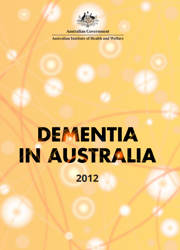Summary
This report provides a comprehensive picture of dementia in Australia, illustrated by the latest available data and information on trends over time.
Number of people with dementia is expected to increase markedly
An estimated 298,000 Australians had dementia in 2011, of whom 62% were women, 74% were aged 75 and over, and 70% lived in the community.
Dementia poses a substantial challenge to health, aged care and social policy. Based on projections of population ageing and growth, the number of people with dementia will reach almost 400,000 by 2020. Although projection methods vary, the number of people with dementia is projected to triple between 2011 and 2050, to reach around 900,000 by 2050.
Dementia is a leading cause of death and burden of disease
Dementia was the third leading cause of death in 2010 (accounting for 6% of all deaths), with an average of 25 people dying from dementia every day that year. Twice as many women as men died from dementia (6,083 and 2,920 respectively). The number of deaths due to dementia increased 2.4 times between 2001 and 2010 (from 3,740 to 9,003 deaths). Some of this increase is due to population ageing and growth, but some may be due to changes in how dementia is recorded on death certificates. Dementia was recorded as the underlying or an additional cause of 14% of deaths in 2010.
Estimates of burden of disease quantify the amount of healthy life lost due to premature death and prolonged illness or disability. Estimates for 2011 suggest that dementia was the fourth leading cause of overall burden of disease, and the third leading cause of disability burden. For people aged 65 and over, dementia was the second leading cause of overall burden of disease and the leading cause of disability burden, accounting for a sixth of the total disability burden in older Australians.
People with dementia rely heavily on health and aged care services
An estimated 552,000 GP attendances (0.5%) in 2010-11 involved the management of dementia. In 2009-10, dementia was a diagnosis for 83,226 (1 in every 100) hospitalisations, and was the principal diagnosis for 12,286 (1 in every 1,000). In that year, 392,796 (0.2%) government-subsidised prescriptions were dementia-specific.
Total direct health and aged care system expenditure on people with dementia was at least $4.9 billion in 2009-10, of which about $2.0 billion was directly attributable to dementia. Of this, $1.1 billion was for permanent residents in residential aged care facilities and $408.0 million was for community aged care services.
Many people with dementia have other health conditions, and many need high care
In 2009, people with dementia aged 65 and over had a substantially higher average number of health conditions (5.4) than all people in that age group (2.9). In 2009-10, 53% of permanent residents in residential aged care facilities had dementia. Residents with dementia were more likely than those without dementia to require high care (87% vs. 63%).
Substantial demand placed on informal carers
Estimates suggest that, in 2011, there were around 200,000 informal carers of people with dementia living in the community. Co-resident primary carers of people with dementia were almost twice as likely as all co-resident primary carers to provide 40 or more hours of care per week (81% versus 42%).
-
Introduction
-
Prevalence, mortality and burden of disease
-
Characteristics of people with dementia
-
Use of health and aged care services
-
Carers of people with dementia
-
Expenditure on dementia
Appendix A: Additional tables
Appendix B: Data sources
Appendix C: Australian longitudinal studies
Appendix D: Technical information
Appendix E: Classifications used
End matter: Acknowledgments; Abbreviations; Symbols; References; List of tables; List of figures



